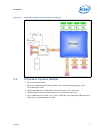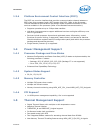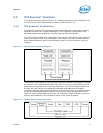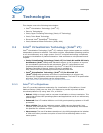
Datasheet 15
Introduction
Intel
®
VT-d
Intel
®
Virtualization Technology (Intel
®
VT) for Directed I/O. Intel VT-d is a hardware
assist, under system software (Virtual Machine Manager or operating system)
control, for enabling I/O device virtualization. Intel VT-d also brings robust security
by providing protection from errant DMAs by using DMA remapping, a key feature of
Intel VT-d.
IOV I/O Virtualization
Jitter Any timing variation of a transition edge or edges from the defined Unit Interval (UI).
JTAG Joint Test Action Group
LGA2011-0 Socket
The LGA2011-0 land FCLGA package mates with the system board through this
surface mount, LGA2011-0 contact socket.
LLC Last Level Cache
MCH Memory Controller Hub
NCTF
Non-Critical to Function: NCTF locations are typically redundant ground or non-
critical reserved; thus, the loss of the solder joint continuity at end of life conditions
will not affect the overall product functionality.
NEBS
Network Equipment Building System. NEBS is the most common set of environmental
design guidelines applied to telecommunications equipment in the United States.
PCH
Platform Controller Hub. The next generation chipset with centralized platform
capabilities including the main I/O interfaces along with display connectivity, audio
features, power management, manageability, security, and storage features.
PCI Express* PCI Express* Generation 2.0/3.0
PCI Express* 2 PCI Express* Generation 2.0
PCI Express* 3 PCI Express* Generation 3.0
PCU Power Control Unit
PECI Platform Environment Control Interface
PLE Pause Loop Exiting
Processor The 64-bit, single-core or multi-core component (package)
Processor Core
The term “processor core” refers to silicon die itself that can contain multiple
execution cores. Each execution core has an instruction cache, data cache, and
256-KB L2 cache. All execution cores share the L3 cache. All DC and AC timing and
signal integrity specifications are measured at the processor die (pads), unless
otherwise noted.
QoS Quality of Service
Rank
A unit of DRAM corresponding four to eight devices in parallel. These devices are
usually, but not always, mounted on a single side of a DDR3 DIMM.
SCI
System Control Interrupt. Used in Advanced Configuration and Power Interface
(ACPI) protocol.
SMBus
System Management Bus. A two-wire interface through which simple system and
power management related devices can communicate with the rest of the system. It
is based on the principals of the operation of the I
2
C* two-wire serial bus from
Philips* Semiconductor.
SSE Intel
®
Streaming SIMD Extensions (Intel
®
SSE)
STD Suspend-to-Disk
STR Suspend-to-RAM
SVID Serial Voltage Identification
TAC Thermal Averaging Constant
TAP Test Access Port
TCC Thermal Control Circuit
TDP Thermal Design Power
TLP Transaction Layer Packet
Table 1-1. Terminology (Sheet 2 of 3)
Term Description


















